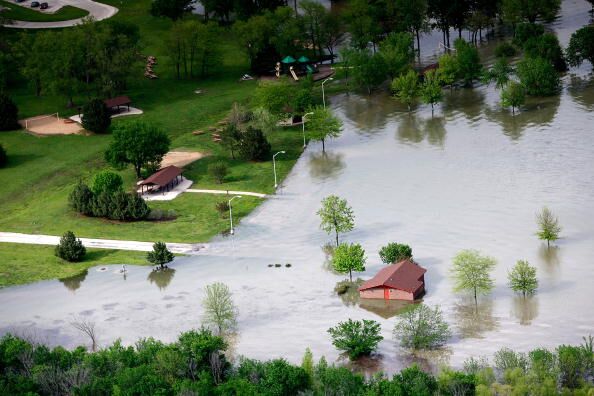
Simultaneous Floods, Droughts Pound U.S.
The Weather Channel celebrates its 25th anniversary this year with unprecedented coverage reaching into 93 million houses around the United States. If the last two months are any indication, demand for coverage could still increase.
It seems that nature has thrown down the gauntlet to the weatherman, storm chaser and natural disaster tracker this season by delivering at both ends of the weather spectrum.
With vicious storms causing flooding in the northeast U.S. all the way down to Kentucky, and drought-fed fires ravaging the southeast and western states, no longer do weather channels face the challenge of making mundane weather interesting. Their challenge these days is deciding which crisis to cover.
Headlines such as “Fires and Floods From East to West U.S.” and “Wildfires, ‘a Major Flood’ and Even a Storm in the Atlantic” highlight the vast variation of disasters simultaneously walloping a nation once renowned for weather-driven prosperity. Rain in due season is quickly becoming just another phrase in the Bible rather than a reality. Instead of natural balance, weather extremes put a dampener on any higher ground taken in the battle against nature.
In April, a major storm system crossed the coast of the North Atlantic, dumping 9 inches on areas around New Jersey and 8 inches in New York City’s Central Park. The storm proceeded to blanket much of the eastern seaboard before it headed inland and eventually swelled the Missouri River, resulting in the breaching of many levies along its banks. National Weather Service meteorologist Suzanne Fortin called it “a major flood” and said that while it won’t be the most devastating ever, “it will be in the top three.”
But while rain was a curse in the north, just a couple of states further south rain would have been a blessing.
In early May, massive fires in both Georgia and northern Florida charred the countryside. Burning over 330 square miles, or 212,000 acres, fires leaped across the landscape closing down two major highways and necessitating evacuations. At one point there were over 1,200 firefighters in Florida—the equivalent of about 1½ army battalions—beating back 236 individual fires. The Georgia fire was the largest on record for the state, but fortunately mostly only burned through forest and swampland.
In the west, the weather scene is not any better. The fire season, which normally starts around the end of June in California, began in March when a fire in Orange County scorched 2,036 acres. Then in May, the Los Angeles area endured two major fires—an 800-acre blaze near Pasadena and a 4,750-acre fire on Santa Catalina Island that forced 3,300 people to evacuate.
While the first wave of fires was not of unprecedented devastation in and of itself, the early onset of fires sets a daunting precedent for the coming year.
With drought conditions now affecting nearly half of the entire U.S., the potential for fire is frightening. The fundamental element for fire prediction is moisture level. The more extreme the drought, the greater the likelihood of an equally extreme fire. In the case of Southern California, the past year has seen the “least amount of precipitation ever recorded” (Register-Guard, May 14). Noting the situation, the captain of the Davis (Calif.) Fire Department said, “If the weather is any indication, I think it is going to be a big fire year” (California Aggie, May 16).
California’s southeastern neighbors Arizona and New Mexico are currently experiencing the “worst drought in 500 years” (Register-Guard, op. cit.). If the parched countryside were to be ignited, it could erupt into a blaze of historic proportions.
Too often, man views his relationship with nature as a battle, doing all he can to offset its attacks with precaution and preemptive strikes such as early-warning systems, more flood-protection levies and forest thinning. But such measures were never meant to be necessary. Mankind, as usual, tries to treat symptoms rather than causes.
God promises multiple times through the Bible that obedience to Him will result in rain in due season, when and where it is needed (Leviticus 26:4; Deuteronomy 11:14; 28:12).
The weather we see today is the result of mankind choosing his own way instead of relying on God. And God’s answer through the Prophet Amos is: “I caused it to rain upon one city, and caused it to not rain upon another city: one piece was rained upon, and the piece whereupon it rained not withered” (Amos 4:7). Amos was a successful herdsman and agriculturalist. He knew the keys to receiving rain in due season and was blessed because of it.
We too can receive those same blessings, if not nationally then on the individual level. But at the same time, realize a time of national prosperity will soon come when even the desert will blossom as a rose (Isaiah 35:1).
Until then, continue to watch and get your fill of the Weather Channel, for in the future there will be no need for it. But for now, it is a sure sign of the times we live in.
